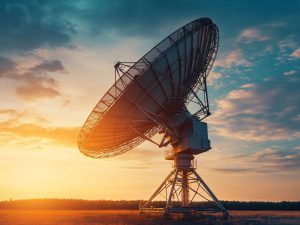Quantum computing opens new frontiers in space research. Researchers are using this technology to transform satellite communications.
For space researchers, the sky has never been the limit. But the development of quantum computing in recent years has opened new doors to push research even further.
Dr Seid Koudia specialises in satellite communications. This area faces many challenges. It needs a lot of energy and response times can be slow, especially over long distances. Also, choosing the right ground station for spacecraft communication remains a key obstacle.
One of the most fundamental challenges in satellite communications is resource allocation – specifically, how to make the best use of limited satellite resources. This is where a classical optimisation challenge known as the Knapsack Problem comes into play.
The Knapsack Problem in satellite communications
The Knapsack Problem is about making the best choices when you have limits. It originally refers to the challenge of packing a backpack and having to decide which items are most important.
In the context of space research, satellites must decide which data to transmit when they can’t send everything at once. Every piece of data (like text messages, video calls, or weather updates) takes up different amounts of the satellite’s resources and has different levels of importance.
So the Knapsack Problem here is about figuring out the optimal mix of data to transmit to get the maximum value while staying within the satellite’s power and bandwidth limits. It’s like deciding whether to pack one large, important item or several smaller, less critical ones in your backpack.
While traditional methods struggle with scaling and real-time decisions due to complex data handling, quantum computing offers a solution.
Using quantum computing for space research
Quantum computing helps optimise energy resources, provides quick responses and chooses the best ground station for communication.
Koudia explains: “By using variational quantum circuits, resources can be allocated more efficiently, improving satellite performance and communication efficiency.”
Variational quantum circuits (VQCs) are a type of quantum algorithm that combines both quantum and classical computing to solve complex problems. They’re like adjustable quantum recipes where one can tune different parameters to get better results – like adjusting the knobs on a sound mixing board to get the perfect audio output.
Because VQCs enhance signal encoding, they help approach channel capacity—the maximum reliable information that can be transmitted through quantum channels. “By adjusting encoding schemes based on channel conditions, near-optimal performance can be achieved” emphasises the Postdoctoral researcher at SnT.
VQCs are valuable because they match today’s imperfect quantum computers perfectly. While quantum hardware still struggles with calculation errors, imprecise operations, and qubits that quickly lose information, VQCs only need the quantum computer for brief moments—handling most of the complex work on regular computers instead.
Navigating quantum computing challenges
Using quantum computing isn’t as simple as it seems. These machines need a lot of computing power and are not readily available. For context, Luxembourg will receive its first quantum computer over the course of 2025.
In the meantime, researchers use quantum computers on the cloud located in other countries. These computers range from a few qubits to nearly 500 qubits in power. But researchers need financial resources to access these computers. Depending on the quantum computer, users pay from zero and up to 96$ per minute of use.
“Quantum computers suffer from extreme sensitivity, requiring extremely cold temperatures to operate properly, which makes them expensive and challenging to maintain”, the Postdoctoral researcher explains. Their current development is also limited by having very few functional qubits, and they frequently produce errors in their calculations, reducing their reliability.
But Koudia believes that the benefits of quantum computing outweigh its downsides, especially when using VQCs. This tool saves time, finds solutions that classical computers miss, is easy to use, and requires less data. These features help push many boundaries in research.
“In summary, I would say that using a quantum computer is not rocket science. But quantum computing absolutely is and will advance rocket science.” he says with a smile
About SigCom
The Signal Processing and Communications (SigCom) research group conducts research aimed at designing, emulating, and testing new high-performance systems for the future of mobile and satellite communications. Fields of applications range from 5G/6G telecommunications to satellite-based internet connectivity.
